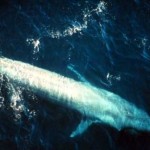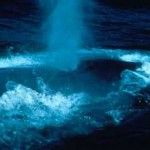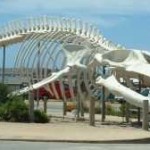An influx of huge krill swarms has drawn an unprecedented number of blue whales to the Monterey, Calif. coast, delighting boatloads of whale watchers throughout early and mid-July.

A "Big Blue"
But it’s not just the endangered blues that are drawing attention.
Joining the big blues—at 108 feet and and 200 tons they are the largest animal existing or known to have existed—are influxes of Humpback whales, Risso’s dolphins, Minke whales (also rarely seen), harbor porpoises, Northern right whale dolphins and Pacific white-sided dolphins.
On one recent whale-watching expedition, people on board sighted 200 whales in a period of just over two hours.
“Enjoy them while you can,” said Wayne Perryman, a researcher with NOAA’s Southwest Fisheries Science Center.

A Big Blue, spouting
He explained that blue whales are designed to cover lots of ground and take advantage of highly productive krill patches, “so they just search around to find a place where there’s lots of it to eat.”
Nancy Black, a marine biologist with the Monterey Bay Whale Watch, discovered the phenomenon in early July when out on a routine whale-watching boat.
She reported nearly 30 of them feeding on krill in a two-mile area, and said she’s only seen such a large concentration of blue whales a couple of times in 20 years.
Black said the sighting of so many blue whales was amazing because there are probably only 10,000 left in the world, with only 2,200 off the California coast.
Moreover, she said the contrast between what’s happening off the Monterey coast and the environmental disaster in the Gulf of Mexico was striking.
“It makes me feel sick (with) birds covered in oil and dying dolphins, and then I was thinking, ‘Gosh, today we have a perfect situation of nature, where it’s how it’s supposed to be,'” Black said.

A humpback whale, breaching
Whales, particularly the pirouetting Humpbacks, favor Monterey Bay (situated about 90 miles south of San Francisco) because of the geography of the bay and its deep, off-shore Monterey Canyon.
The undersea canyon extends 95 miles into the Pacific Ocean, where it terminates at the Monterey submarine fan, reaching depths of up to 11,800 feet.
Though the canyon’s bottom is about two miles below the surface, the actual canyon itself is only about one mile deep, making it of comparable depth to the Grand Canyon. The canyon’s depth and nutrient availability (due to the regular influx of nutrient-rich sediment), as well as its proximity to the coastline, provide a habitat suitable for many marine life forms.
But only rarely does the canyon and its waters draw this number of blue whales.

Krill swarm
The answer is all about krill, tiny shrimplike creatures whose role in marine biology is central to the health of other life forms. Krill are near the bottom of the food chain—they feed on phytoplankton and to a lesser extent zooplankton— and convert these into a form suitable for many larger animals for which krill makes up the largest part of their diet. That would include blue whales.
An adult blue whale can eat up to 40 million krill in a day. The whales always feed in the areas with the highest concentration of krill, sometimes eating up to 7,900 pounds of krill in a single day. This daily calorie requirement of an adult blue whale is in the region of 1.5 million.
Blue whales typically feed at depths of more than 330 feet during the day and only surface-feed at night. Dive times are typically 10 minutes when feeding, though dives of up to 20 minutes are common. The longest recorded dive is 36 minutes. The whale feeds by lunging forward at groups of krill, taking the animals and a large quantity of water into its mouth.

Blue whale skeleton, UC-Santa Cruz
The water is then squeezed out through the baleen plates by pressure from the ventral pouch and tongue. Once the mouth is clear of water, the remaining krill, unable to pass through the plates, are swallowed. The blue whale also incidentally consumes small fish, crustaceans and squid caught up with krill.
Depth soundings off the Monterey coast indicate the krill—the tiny crustaceons swarm as a defense mechanism— was 200 feet to 400 feet, top to bottom, with 200 feet thick of krill for many miles out to sea.
It is not known how long the krill will stay, and thus it is not known how long the whales will stay.
But as of mid-July, both krill and whales were holding steady in Monterey Bay, making it a once-in-a-lifetime opportunity for whale watchers.
—George Shirk/Newsdesk
VIDEO: Blue whale sightings on rise in Monterey Bay (KGO-TV, San Francisco)
CITATIONS:
Best of times for whale watchers off Monterey
SFGate.com, July 11, 2010
Montereybaywhalewatch.com
Current
An Extraordinary Number of Blue Whales and
Humpback Whales Arrive to Monterey Bay
GoWhales.com., July 2010
Blue whales, drawn by multitude of krill, emerge for a feeding frenzy
Santa Cruz Sentinel, July 7, 2010
Spotting Of 28 Blue Whales ‘Once In Decade Event’
KSBW-TV, July 6, 2010
Yes, it is great to hear of ocean wildlife living as they should. Sounds like a sight worth seeing!
Pingback: Big Sur | California Travels